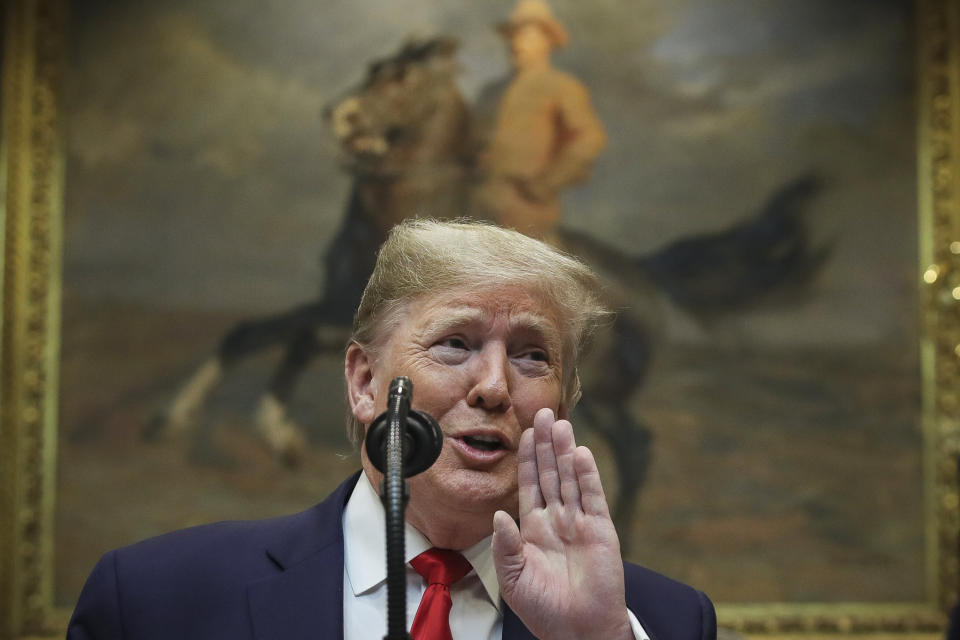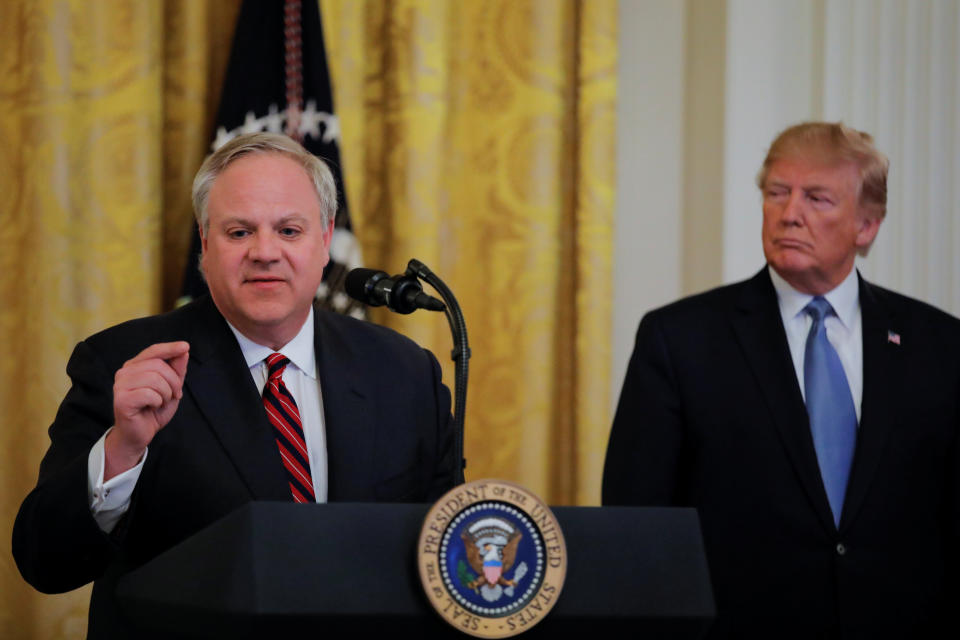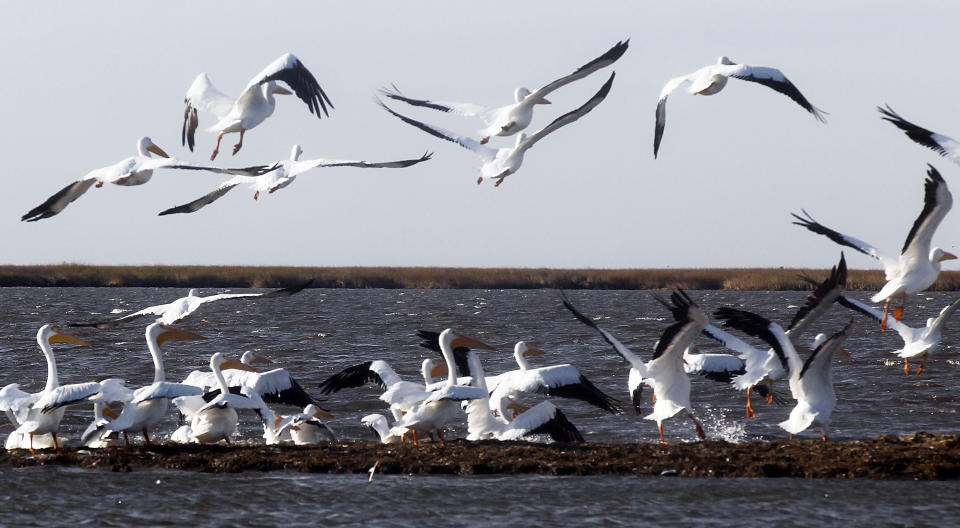6 Times Trump Ramped Up His Assault On The Environment Since 2020's Start
President Donald Trump, a well-established serial liar, has been working in recent months to persuade the American public that his extreme anti-regulatory agenda is good for the planet and human health.
During a speech on the environment last July, Trump boasted about the work he and his team have done to “preserve” the nation’s “incredible natural splendor.” Asked in early January about climate change, a global threat that he’s previously dismissed as a hoax, Trump said, “Nothing’s a hoax about that. It’s a very serious subject.” And while addressing world leaders last month in Davos, Switzerland, the president declared that “the United States has among the cleanest air and drinking water on Earth ― and we’re going to keep it that way.”
As Trump greenwashes his record ahead of the 2020 election ― an effort that will almost certainly continue during Tuesday night’s State of the Union address ― the administration is plowing ahead with an agenda that overwhelmingly benefits polluting industries at the expense of the climate, clean air and water, wildlife and public lands.
Ten of the country’s leading environmental groups, including Earthjustice and the League of Conservation Voters, issued a joint statement ahead of Trump’s Tuesday speech condemning his “unprecedented assault on our environment and the health of our communities.”
“No amount of his greenwashing can change the simple fact: Donald Trump has been the worst president for our environment in history,” the groups wrote. “Unfortunately, our children will pay the costs of this president’s recklessness.”
In the first three years of Trump’s tenure, the administration has reversed or is in the process of rolling back nearly 100 environmental rules and regulations, from replacing the Clean Power Plan to weakening the Endangered Species Act, according to a New York Times analysis.
Here’s what he’s done in just the first month of 2020 ― none of which are likely to get a mention tonight.

Extending an anti-environmentalist’s tenure as public lands chief
The administration kicked off the new year by extending William Perry Pendley’s stint as acting director of the Bureau of Land Management, further shielding him from the scrutiny of a Senate confirmation process that a formal nomination would trigger.
A self-proclaimed “sagebrush rebel,” Pendley holds extreme anti-environmental views and has a long history of advocating for the sale of the federal lands he now manages. The Wyoming native is the former longtime president of Mountain States Legal Foundation, a Colorado-based conservative legal nonprofit, and been called the “ideological twin” of James Watt, the controversial Interior Department chief under President Ronald Reagan.
Pendley has slammed the Endangered Species Act as a tool “to kill or prevent anybody from making a living on federal land,” railed against what he terms environmental “terrorists” and “eco-fascists,” and compared the climate crisis to a “unicorn.”
He also has ties to the late cult leader, convicted fraudster and paranoid conspiracy theorist Lyndon LaRouche, as HuffPost reported. In the early 1990s, he published anti-environmental pieces in 21st Century Science & Technology, a fringe LaRouche magazine loaded with pseudoscience and conspiracy theories.
Pendley has said repeatedly that his personal views and past actions, including his views on federal land policy and connections to LaRouche, are “irrelevant” to the job of managing more than one-third of all federal land.
Limiting environmental reviews
Next came the administration’s long-anticipated attack on what is arguably America’s most important environmental law, the National Environmental Policy Act. This 50-year-old law protects air, water and land by requiring federal agencies to look closely at the potential environmental impacts of major infrastructure projects.
Trump’s proposal, unveiled Jan. 9, looks to streamline the permitting process for pipelines, power plants, highways and other development by limiting the number of projects that require in-depth environmental review and expediting the process for those that do. Equally as significant, it would allow agencies to ignore a project’s vulnerability to climate change, as well as its “cumulative” effects on global warming ― at a time when billion-dollar climate and weather disasters are on the rise.
How significant would this change be? In announcing the administration’s plans, Interior Secretary David Bernhardt, a former oil lobbyist, said the reforms “will be the most significant deregulatory proposal” the president implements during his time in office and effect “virtually every significant decision made by the federal government that affects the environment.”

Eroding water protections
Trump talks often about how his team works to ensure Americans have “crystal clean” water. Undermining that promise, however, is the administration’s decision last month to remove protections for about half the nation’s wetlands and hundreds of thousands of streams.
That rule, which the Environmental Protection Agency and the Army Corps of Engineers finalized Jan. 23, replaces President Barack Obama’s 2015 Waters of the United States regulation, better known as WOTUS or the Clean Water Rule. The rule extended federal safeguards to 2 million miles of streams and 20 million acres of wetlands.
Trump went well beyond simply scrapping the regulation, instead eliminating Clean Water Act protections for bodies of water that have been in place for decades. Experts warn that the move could prove devastating for drinking water resources, wildlife and food security.
“If allowed to stand, this bulldozing of clean water protections would be among this administration’s dirtiest, most dangerous deeds,” Blan Holman, a lawyer and water expert at the Southern Environmental Law Center, previously told HuffPost.
Sacrificing migratory birds
Much like former Interior Department chief Ryan Zinke, Trump has become fixated on the negative impacts of wind turbines on birds. “You want to see a bird graveyard?” Trump asked at a summit in Florida last month. “Go under a windmill someday.”
Trump’s professed concern for feathered species hasn’t stopped him from making it easier for companies to kill birds.
Last week, the U.S. Fish and Wildlife Service issued a proposed rule to codify 2017 guidance from the Interior Department’s top lawyer that legalizes the incidental killing of migratory birds, including deaths caused by fossil fuel operations, power lines and wind turbines. The administration’s position is that the 100-year-old Migratory Bird Treaty Act solely prohibits the intentional hunting, killing or capturing of bird species.
The biggest beneficiaries of the change are fossil fuel interests, power companies and major developers, which the administration says should be able to operate without fear of prosecution. The USFWS acknowledges in its proposed regulation that the rollback will result in industries doing less to prevent incidental avian deaths, as E&E News first reported.

Approving neurotoxic insecticides
Another recent Trump administration decision also puts birds at risk. Last Thursday, the EPA formally announced its support for the continued use and registration of five neurotoxic insecticides that studies show are wiping out populations of songbirds and bees.
In a set of proposed interim decisions, the agency put some new restrictions on acetamiprid, clothianidin, dinotefuran, imidacloprid and thiamethoxam, chemicals collectively known as neonicotinoids. But the EPA bucked calls from environmentalists to ban or seriously limit the pesticides, which are also linked to developmental problems in human babies.
Allowing more “forever chemicals” on the market
For much of the past year, the EPA has been touting its efforts to curb per- and polyfluoroalkyl substances, or PFAS, the so-called forever chemicals contaminating the drinking water of at least 19 million Americans.
Yet as the agency dithers on strict new rules, it looks poised to approve four new varieties of the chemical, HuffPost reported this week.
Among them is a compound that’s “lethal if inhaled” and “corrosive to the skin,” an EPA fact sheet showed. Others present a “severe health hazard,” including “irreversible injury” and “life-threatening, permanent or major injury” from “a single or repeated exposure.”
Love HuffPost? Become a founding member of HuffPost Plus today.
Related...
Trump's Latest Environmental Rollback Is A Middle Finger To Common Sense
Trump Administration Shoots Down Migratory Bird Protections
The Environmental Protection Agency Keeps Approving Dangerous Chemicals
This article originally appeared on HuffPost.

